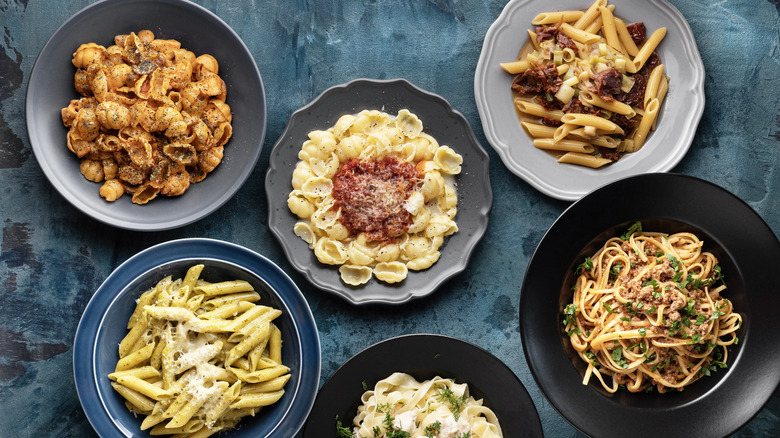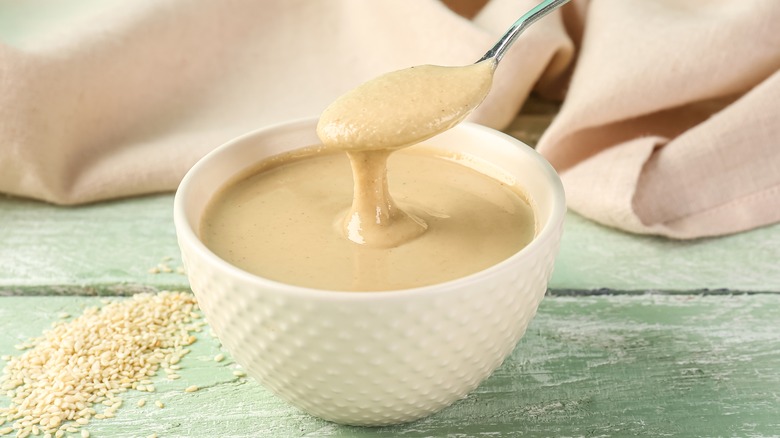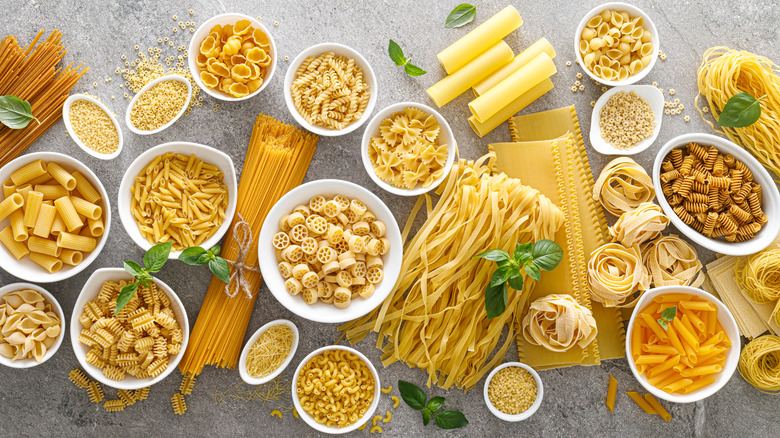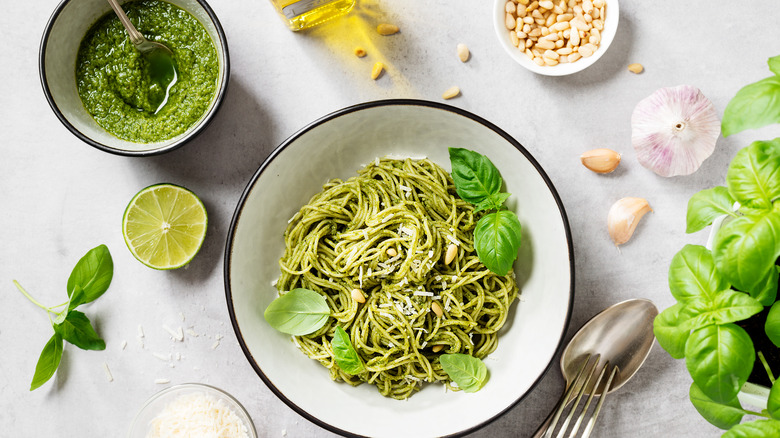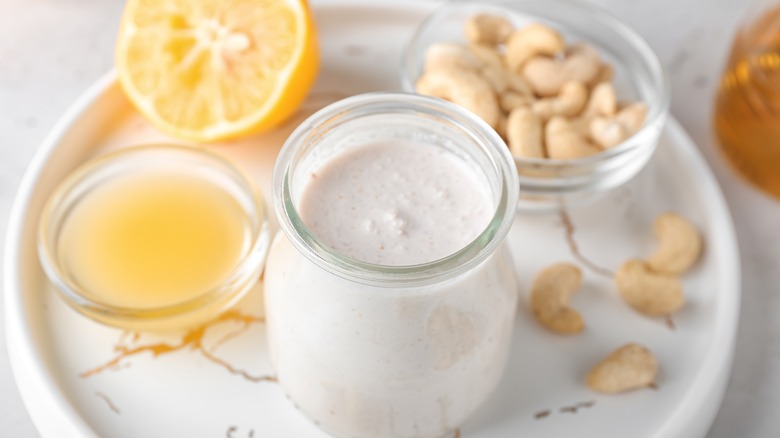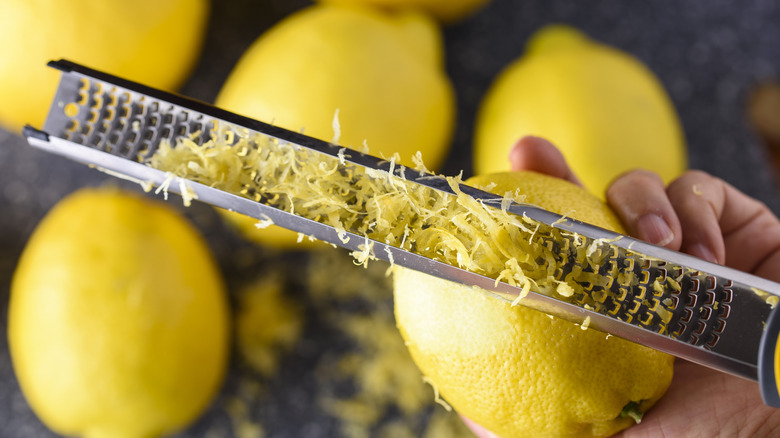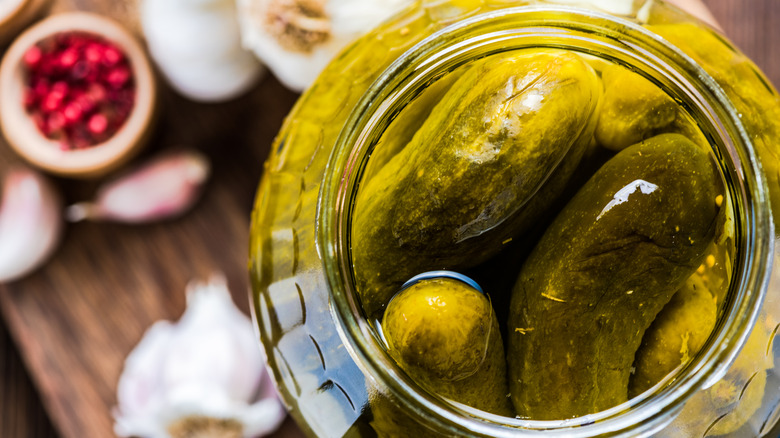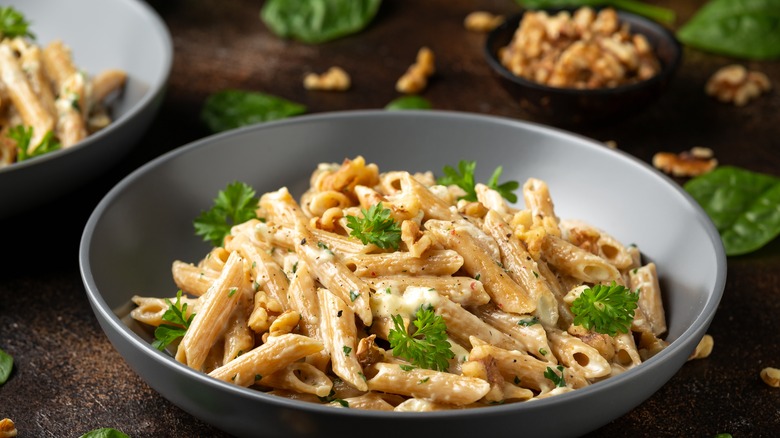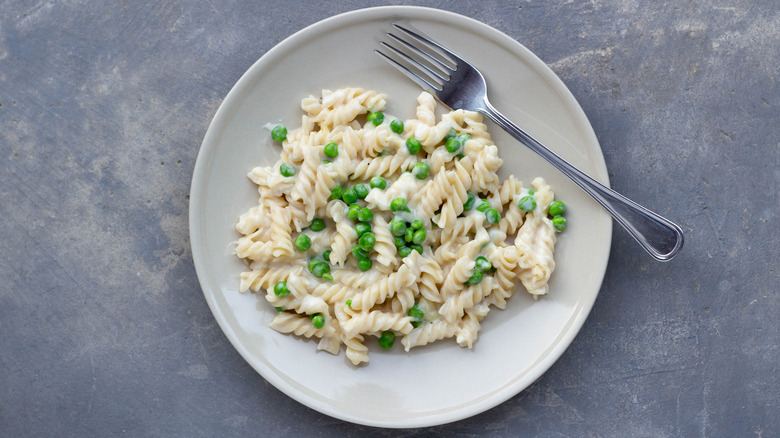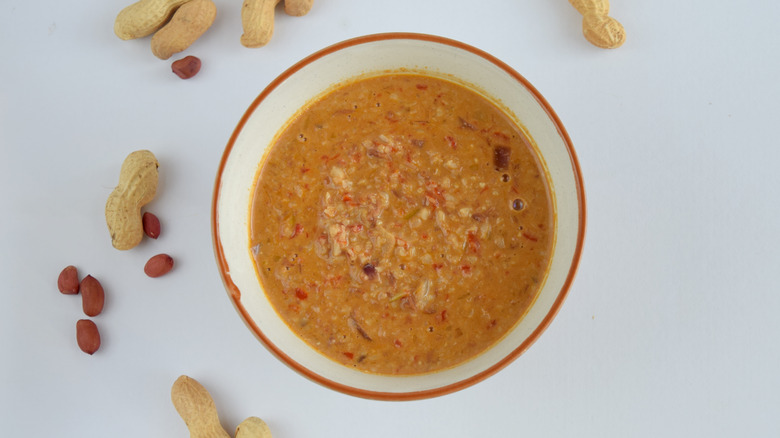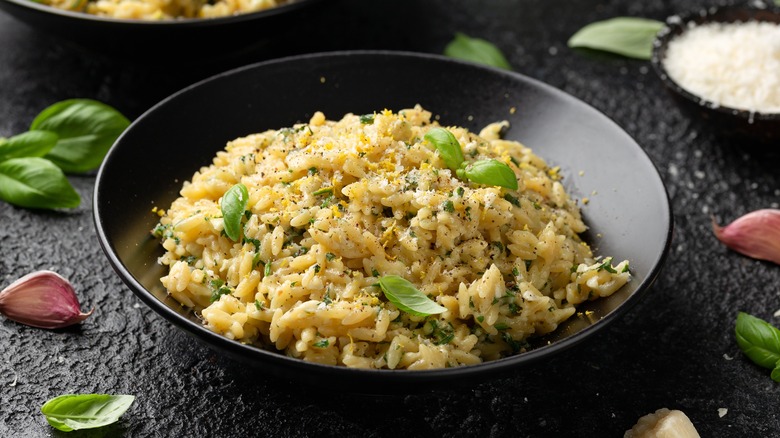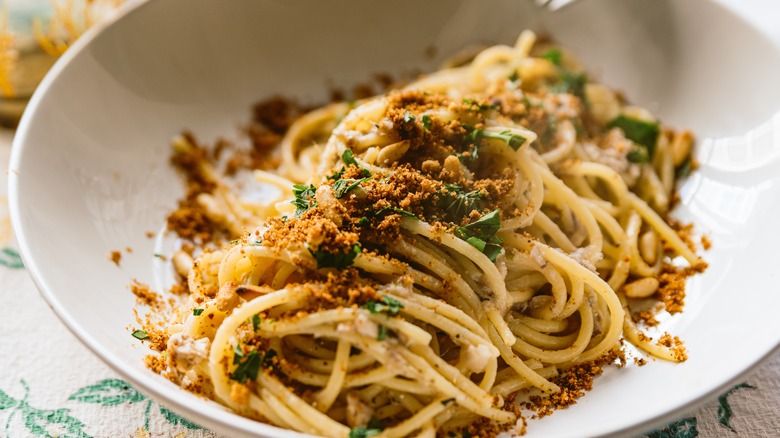13 Unexpected Ways To Upgrade Your Pasta Dishes
We love talking about pasta. It's truly one of the best foods in the world — it's no wonder that it's a favorite in so many households. But what if you could elevate this classic dish to new heights? We have some unexpected ways to upgrade your pasta dishes, which is great news for anyone who loves pasta, but feels like they're stuck in a noodle-shaped rut.
Beyond traditional red sauces and basic meatballs lies a realm of possibilities waiting to be discovered. Imagine savoring the tantalizing flavors of cashew cream, tahini, bourbon, breadcrumbs, and other unexpected ingredients melded perfectly with al dente pasta. There are so many ways to get creative with your pasta dishes, and we've got some of the best for you here.
Whether you're a beginner looking to expand your kitchen skills or a seasoned chef seeking inspiration, these upgrade ideas will inspire you to rethink the way you approach pasta. Embrace the fusion of flavors, experiment with diverse ingredients, and discover the joy of surprising your taste buds. With these 13 unexpected ways to upgrade your pasta dishes, you'll up your pasta game in ways that are both surprising and delicious.
1. Cook pasta in red wine instead of water
Cooking pasta in red wine rather than water is an unconventional method that infuses the noodles with a rich, complex flavor. If you love rich red wine tomato sauces, then you might appreciate the flavors of red wine pasta.
To start, choose your red wine. While using super expensive red wine is a waste, a good rule for cooking with wine is to always pick a wine that you'd be happy to drink. You're not going to suddenly love food cooked with a heavy shiraz if you usually like light-bodied red wine. You can experiment with ratios, but most people use about a 3-to-1 ratio of red wine to water, although you can use just red wine if you like. Select a pasta shape and cook it in the simmering wine until it reaches the desired tenderness.
You'll then drain the pasta, but reserve at least a ¼ of a cup of the cooking liquid. It's best to enjoy your red wine pasta with a simple sauce, such as garlic sautéed in olive oil, perhaps with some hard cheese to finish. Cooking pasta in red wine offers a departure from traditional methods. It demonstrates how experimenting with unexpected combinations can yield extraordinary and flavorful results, turning a simple dish into a gourmet experience.
2. Add tahini to sauces for creaminess
Adding tahini to pasta sauce is an unexpected yet ingenious way to introduce creaminess and depth of flavor to your dish. Tahini, a paste made from ground sesame seeds, is often associated with Middle Eastern cuisine. Its velvety texture and nutty taste can transform a basic pasta sauce into a rich and satisfying culinary delight. When incorporated into pasta sauce, tahini acts as a natural thickener, creating a creamy, smooth texture without the need for heavy cream or cheese. This not only caters to those with dietary restrictions, but also provides a unique, earthy undertone that makes the sauce taste even better.
To use tahini in your pasta sauce, simply whisk it into the sauce while it's simmering on the stove. The tahini will blend seamlessly, infusing the sauce with a subtle nuttiness and a luxurious, creamy consistency. Its versatility allows it to complement a variety of flavors, making it an excellent addition to a range of sauces. You can also make creamy pasta sauces where tahini is the star of the show. These are best for true tahini lovers, as the sesame flavor is prominent. This kind of sauce is an excellent alternative to creamy pasta sauce for vegans and people who are lactose-intolerant.
3. Toast your pasta before using it
Pasta and toasting aren't two words that seem to go together. But toasting pasta before using it is a simple technique that can really upgrade pasta dishes from basic to gourmet — no matter how unconventional it might sound. This method involves cooking pasta in a dry skillet until it becomes golden brown and aromatic before boiling it in water. The toasting process adds a nutty flavor and enhances the pasta's overall texture, making it a versatile base for a variety of recipes.
When you toast pasta, the natural sugars in the noodles caramelize, developing a deeper, more complex taste. To toast pasta, start by placing the dry noodles in a skillet over medium heat. Stir the pasta continuously to prevent burning, and within a few minutes, you'll notice the noodles turning golden brown and emitting a delicious aroma. It's crucial to keep a close eye on the pasta during this process, as it can quickly go from toasty and flavorful to burnt and bitter.
Once the pasta is toasted just how you like it, transfer it to a pot of boiling water and cook it until al dente. Toasted pasta pairs well with a variety of sauces, from light olive oil and garlic to rich, hearty ragùs. Cooking with toasted pasta adds depth and character to your meals. Whether you're preparing a quick weeknight dinner or a special weekend feast, this simple technique can turn an ordinary dish into a showstopper.
4. Use fresh herbs instead of dried
There's a simple way to upgrade your pasta dishes that might not have crossed your mind — using fresh herbs instead of dried herbs. Fresh herbs provide a nuanced flavor and bright aroma that dried herbs simply can't match. What's cool about using fresh herbs is their intense, aromatic flavors. Unlike their dried counterparts, which often lose their potency over time, fresh herbs are brimming with flavor. For instance, basil adds a sweet, slightly peppery note, while parsley contributes a fresh, grassy taste. The sharpness of fresh cilantro and the earthiness of thyme can transform a mundane pasta dish into a culinary masterpiece.
Another benefit of fresh herbs is that they look great on the plate. The vibrant green hues make your pasta dishes look even more appetizing. Stirring fresh herbs through your recipe or garnishing your pasta with a sprinkle of finely chopped fresh herbs just before serving not only makes it look good, but also infuses the entire dish with a burst of color and fragrance.
When using fresh herbs in your pasta recipes, timing is crucial. Add delicate herbs like basil and cilantro at the end of cooking to preserve their flavors. Robust herbs like rosemary and thyme can withstand longer cooking times, infusing the sauce with its essence as it simmers.
5. Try cashew cream in place of heavy cream
If you're looking for a way to make your pasta dishes rich and creamy with a nuttiness that you won't get from heavy cream, you need to try cashew cream. Not only does it give your dishes a gourmet level of nuttiness, but substituting cashew cream for heavy cream in pasta recipes makes them dairy-free and vegan-friendly.
To make cashew cream, soak raw cashews in water for a few hours or overnight. Then, drain and rinse the cashews thoroughly before blending them with fresh water until smooth. Ideally, use a high-powered blender to avoid graininess in the finished dish. The result is a velvety, dairy-free alternative that can be used in a variety of dishes, especially in creamy pasta sauces.
When mixed into pasta recipes, cashew cream is luscious with a silky texture that clings to the noodles, making pasta dishes feel even more decadent. Its neutral taste allows it to harmonize beautifully with various flavors. Whether you're preparing a classic Alfredo, a savory mushroom stroganoff, or a spicy Cajun pasta, cashew cream seamlessly blends with other ingredients, creating a satisfying, restaurant-quality dish in the comfort of your own kitchen.
6. Use lemon zest in tomato-based sauces
You've probably added lemon juice to sauces before, but what about lemon zest? Adding lemon zest to a tomato-based pasta sauce brings brightness and depth to your dish. Lemon zest, the outermost layer of the lemon peel, is rich in essential oils, carrying the fruit's intense citrus aroma and flavor. When added to a savory tomato sauce, it acts as a natural enhancer, elevating the taste profile with a refreshing, zesty twist.
The acidity of the lemon zest complements the richness of the tomato sauce, which gives your sauce balance. Just a sprinkle of lemon zest can transform a seemingly ordinary pasta sauce into something special. What's great about using zest instead of juice is that it adds a zingy brightness without inviting acid to the party. Since tomatoes are already acidic enough, the zest is all you need. When adding lemon zest to marinara sauce and other tomato-based pasta sauces, make sure you do it at the very last minute once the sauce is off the heat and you're ready to mix it through the pasta. This preserves the flavor of the lemon zest, otherwise, it'll quickly cook off.
7. Add a splash of pickle juice to creamy or cheesy sauces
Creamy and cheesy pasta sauces are delicious, but they can sometimes be heavy. And, if you're not careful, they can taste a bit one-note. So, if you're looking for something to cut through and add complexity, try pickle juice. Yes, that's right, the stuff your jarred pickles hang out in. It's also a great mix-in for pasta salad.
The acidity of pickle juice acts as a natural brightener, cutting through the richness of creamy or cheesy sauces with a tangy zing. This unexpected addition transforms a mundane pasta dish into a flavorful, multidimensional experience. What's more, there's some sweetness to pickle juice, so it's not just straight-up acidic. Pickle juice often has aromatics added, such as dill and mustard seeds, which just bring even more flavor to your pasta dishes.
When experimenting with this technique, it's important to start with a small amount of pickle juice and adjust to your taste preference. A mere splash can have a transformative effect, so it's wise to add gradually and taste as you go. The subtle infusion of tangy pickle juice can be especially appealing in sauces featuring ingredients like cheddar, Parmesan, or heavy cream, as it cuts through the richness, making the flavors more vibrant.
8. Toast nuts to top your pasta
Toasted nuts — whether that's almonds, pine nuts, walnuts, or any other variety — can really upgrade your pasta. Their crunchy texture and rich, nutty flavor add a delightful contrast to the softness of pasta. Some of the best dishes experiment with contrasting textures and this is a great way to do that. Whether you're indulging in a creamy Alfredo, a zesty pesto, or a simple olive oil and garlic pasta, toasted nuts are a versatile topping that can make your pasta special.
The toasting process enhances the natural oils and deepens the flavors of the nuts, bringing out their inherent richness. To toast nuts, simply heat them in a dry pan over medium heat, stirring frequently until they become golden brown and fragrant. Just watch that you don't toast them too much as it's easy for them to catch and burn. Once toasted, let them cool slightly before chopping or sprinkling them over your pasta. What we love about toasted nuts is their ability to complement a wide range of pasta ingredients. So, whether you're making a creamy sauce, pesto pasta, or a rich tomato sauce, there's a place for toasted nuts.
9. Put peas in your mac and cheese
Mac and cheese is almost universally loved, but it can be stodgy, so it's nice to have some contrast. Adding peas to mac and cheese helps transform a classic comfort food into a dish that is not only rich and indulgent but also fresh and vibrant. The sweet, pop-in-your-mouth goodness of peas adds flavor and color while cutting through the creamy cheesiness, balancing the dish beautifully. Also, remember that you don't always have to use macaroni. Any pasta shape is great with a cheesy sauce.
Although delicious, mac and cheese can sometimes feel a bit heavy, especially when enjoyed in large quantities. Peas, however, bring a welcome contrast. Their natural sweetness and slightly crisp texture create a delightful counterpoint to the gooey cheese sauce, breaking up the richness, and adding a layer of freshness. Adding peas is a small but significant change that refreshes this beloved dish, making it more balanced, flavorful, and visually appealing. So, the next time you prepare mac and cheese, consider tossing in a handful of peas — it's a simple, yet effective way to elevate this classic comfort food.
10. Add bourbon to pasta sauce
People add wine and even vodka to pasta dishes, so why not bourbon? Introducing bourbon into pasta sauces is an unexpected and daring culinary venture that infuses your dishes with a rich, intriguing depth of flavor. The smoky, caramel notes of bourbon add a unique complexity to sauces, transforming a simple pasta meal into something that belongs on the menu of a high-end restaurant.
When incorporated thoughtfully, bourbon doesn't overpower the dish — instead, it mingles with the other flavors, so the whole is greater than the sum of its parts. Its warm, woody undertones complement a variety of ingredients, making it a surprisingly versatile addition to pasta sauces.
There are many recipes out there that incorporate bourbon into pasta sauce, so you're sure to find one you like. However, they're often creamy pasta sauces, where the sweetness of the bourbon plays off against the rich creaminess of the rest of the sauce. The result is a dish that boasts a complex blend of sweetness, smokiness, and depth. Start by adding just a little bourbon and adjust up from there so you don't overwhelm the dish.
11. Try a peanut butter sauce
You might be thinking, "peanut butter in pasta sauce — really?!" but consider it a fusion dish that blends the type of peanut sauce found in various Asian cuisines with Italian pasta. It showcases the versatility of peanut butter in unexpected ways. This innovative recipe blends the savory goodness of pasta with the creamy, nutty richness of peanut butter.
Originating from the culinary melting pot of fusion cuisine, peanut butter pasta combines elements from different culinary traditions. Its roots can be traced back to various Asian cuisines — such as Thai, Malaysian, and Cambodian — where peanut-based sauces are common. In this fusion dish, traditional Italian pasta meets the vibrant flavors of Southeast Asia, creating something delicious. While you might be skeptical at first, if you'd eat peanut sauce or satay sauce with Asian noodles, why not with pasta noodles?
The preparation of peanut butter pasta is surprisingly simple. Cook your favorite pasta to al dente perfection, then toss it in a sauce made from peanut butter, soy sauce, garlic, ginger, and a hint of chili for a touch of heat. The result is a velvety, nutty sauce that coats the pasta, infusing it with a blend of savory, umami, and spicy notes. You can even add coconut milk or coconut cream for extra richness.
12. Cook your pasta risotto-style
Cooking pasta in a risotto style transforms ordinary pasta into a creamy dish reminiscent of traditional Italian risotto. This method involves cooking pasta slowly in a flavorful broth, letting the noodles absorb the liquid gradually, resulting in a rich, velvety texture. To cook pasta risotto-style, start by sautéing aromatics such as onions and garlic in olive oil or butter until they become translucent. Then, add your choice of pasta — short varieties like penne or farfalle work well, as does orzo — and toast it in the pan for a minute or two. This toasting process enhances the nutty flavor of the pasta, adding depth to the final dish.
Once the pasta is toasted, begin adding warm broth or stock one ladle at a time, allowing the liquid to be absorbed by the pasta before adding more. Stir the pasta continuously and maintain a gentle simmer, allowing the noodles to gradually release their starches into the sauce, creating a creamy consistency without the need for heavy cream or cheese. As the pasta absorbs the liquid, it becomes tender yet toothsome, and the starches released from the noodles thicken the sauce, creating a velvety, risotto-like texture. This slow, meticulous process requires patience and attention, but rewards you with a dish that's comforting and indulgent.
13. Mix breadcrumbs through your pasta
Want to upgrade your pasta from simple to sumptuous? Breadcrumbs might be the answer. On their own, breadcrumbs are humble and not worth writing home about, but when toasted, seasoned, and mixed through pasta, they add a delightful crunch and an unexpected layer of texture. This is a simple upgrade but one that can make a pasta dish feel special and taste amazing.
To incorporate breadcrumbs, start by toasting them in a dry pan until they turn golden brown and fragrant. Toasting brings out the nutty flavor of the breadcrumbs, enhancing their taste and texture. They're even better if you add garlic, herbs, salt, and pepper for extra flavor. Once the breadcrumbs are toasted, mix them thoroughly with your cooked pasta. The breadcrumbs adhere to the noodles, creating a crispy coating that contrasts beautifully with the softness of the pasta. This technique works exceptionally well with long pasta like spaghetti or linguine, as the breadcrumbs cling to the strands, enveloping each bite in a delightful crunch. It's best with a basic pasta sauce, such as aglio e olio or cacio e pepe.
